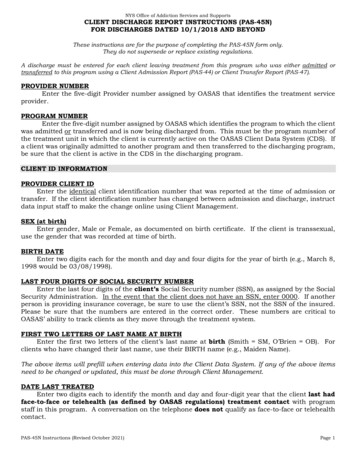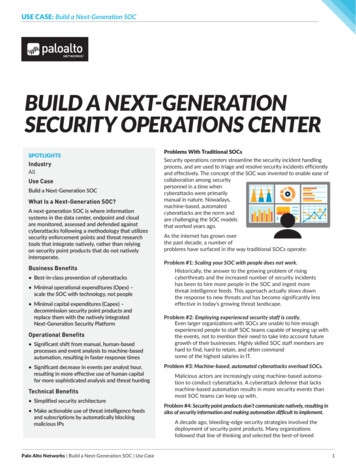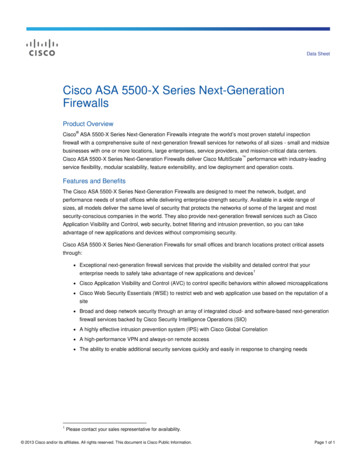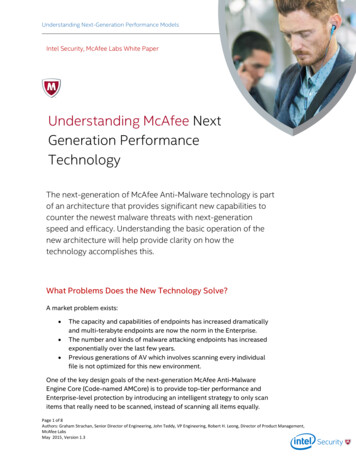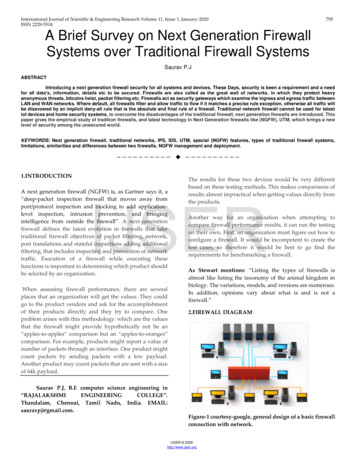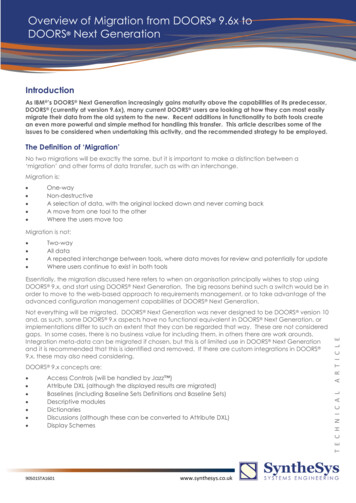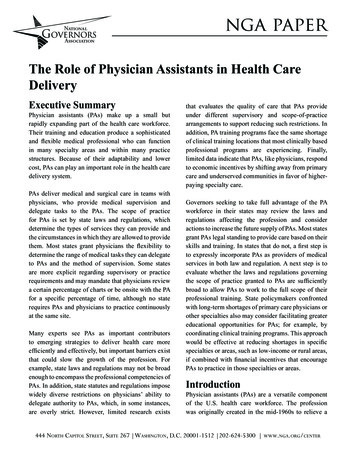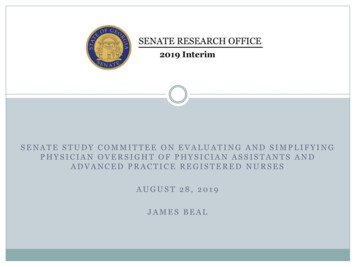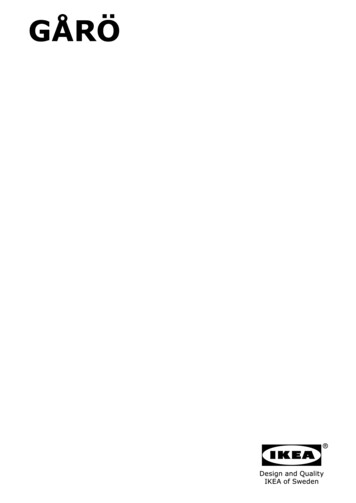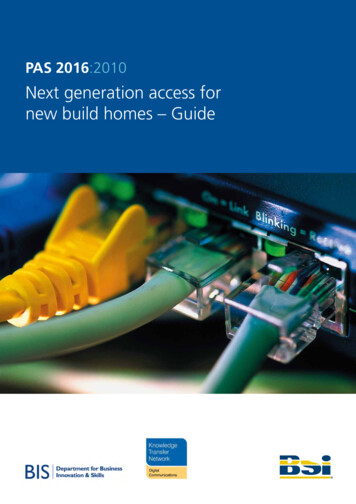
Transcription
PAS 2016:2010Next generation access fornew build homes – Guide
PAS 2016:2010Publishing and copyright informationThe BSI copyright notice displayed in this document indicates when the documentwas last issued. BSI 2010ISBN 978 0 580 67917 9ICS 33.040.01; 91.040.30No copying without BSI permission except as permitted by copyright law.This Publicly Availble Specification comes into effect on 6th December 2010Amendments issued since publicationDateText affected BSI December 2010
PAS 2016:2010 Contents Foreword . iiIntroduction . iii1 Scope . 1 2 Normative references . 13 Terms and definitions . 24 Domestic dwelling digital infrastructure . 45 Boundary between internal and external infrastructure . 56 External infrastructure . 87 Internal digital infrastructure . 98 Installation testing . 14 9 Documentation and handover . 15 Bibliography . 16 List of figuresFigure 1 – Domestic digital installations . 6 Figure 2 – Generic zones of liability . 7 Figure 3 – Pin grouping and pair assignments for BS EN 60603-7 seriesconnecting hardware (front view of connector) . 12 Figure 4 – Cable ducting diagram . 13 BSI December 2010i
PAS 2016:2010Foreword This Publicly Available Specification (PAS 2016:2010), was sponsored by theDepartment for Business, Innovation and Skills (BIS) and its development wasfacilitated by the British Standards Institution (BSI).Acknowledgement is given to Mike Perry of BRE (theBuilding Research Establishment) as the TechnicalAuthor for this Publicly Available Specification.BSI also wishes to acknowledge the followingorganizations that were involved in the developmentof this Publicly Available Specification: BT; Derby City Council; Digital Communications Knowledge Transfer Network(DC-KTN); HCA; Independent Fibre Networks Ltd & NICC; Land Securities; Miniflex; OpenHub; PRP; Willmott Dixon.Wider comments from other interested parties wereinvited by BSI. The expert contributions made bythe organizations and individuals consulted in thedevelopment of this Publicly Available Specificationare gratefully acknowledged.This PAS has been prepared and published by BSI, whichretains its ownership and copyright. BSI reserves theright to withdraw or amend this PAS on receipt ofauthoritative advice that it is appropriate to do so.This PAS will be reviewed at intervals not exceedingtwo years, and any amendments arising from thereview will be published as an amended PAS andpublicized in Update Standards.Use of this documentAs a guide, this Publicly Available Specificationtakes the form of guidance and recommendations.It should not be quoted as if it were a specificationand particular care should be taken to ensure thatclaims of compliance are not misleading.iiAny user claiming compliance with this PubliclyAvailable Specification is expected to be able tojustify any course of action that deviates from itsrecommendations.It has been assumed in the preparation of thisPublicly Available Specification that the executionof its provisions will be entrusted to appropriatelyqualified and experienced people, for whose use ithas been produced.Presentational conventionsThe provisions in this standard are presented in roman(i.e. upright) type. Its recommendations are expressedin sentences in which the principal auxiliary verb is“should”. It does not contain requirements.Commentary, explanation and general informativematerial is presented in smaller italic type, and doesnot constitute a normative element.The word “should” is used to express recommendationsof this standard. The word “may” is used in the textto express permissibility, e.g. as an alternative to theprimary recommendation of the clause. The word “can”is used to express possibility, e.g. a consequence of anaction or an event.Notes and commentaries are provided throughoutthe text of this standard. Notes give references andadditional information that are important but do notform part of the recommendations.Contractual and legal considerationsThis publication does not purport to include all thenecessary provisions of a contract. Users are responsiblefor its correct application.Compliance with a British Standard cannot conferimmunity from legal obligations. BSI December 2010
PAS 2016:2010 Introduction The UK is embarking on the process of installinga national digital infrastructure, to support thedelivery of broadband digital services, particularlyto the home setting via high-speed internet access,referred to in this Public Available Specification (PAS)as “broadband”. The Coalition Agreement providesthe Government’s views, aspirations for superfastbroadband and objectives on how this can be achieved.The Government aims to ensure the UK has the bestsuperfast broadband network in Europe by 2015.This is tackled in more detail in the Government’sNational Broadband Strategy: Britain’s SuperfastBroadband Future, published in December 2010.A digital infrastructure has two parts to it, connectionto the house and distribution within the house. Thisparallels with the delivery of electricity. Service deliverydepends on “end-to-end connectivity”, i.e. a connectionfrom the broadband supplier right through to thedevice situated within the home, and thereforeneeds both parts of the distribution system.The initial residential use of the internet was drivenby PC-based services such as web browsing and email.Subsequent use has increasingly included a wider rangeof applications, including video and others, whichwill involve machine to machine communication forapplications such as meter reading, security, telecare,etc. This development has involved an increase in thenumber of devices to be connected in individual homesand this trend will continue.An easier challenge is to install digital infrastructureinto all new build domestic dwellings. While cabledmedia is the preferred digital infrastructure, particularlyfor demanding high bandwidth video distribution,wireless connectivity is also likely to play a significantrole. Wireless provides convenience and flexibilityfor the connection of mobile devices in particular,e.g. laptops. BSI December 2010A network in the home benefits the delivery of thedigital services as well as providing convenienceto the home owner. This also has the potential ofproviding the developer with an attractive marketingopportunity.iii
PAS 2016:2010 1 Scope2 Normative referencesThis Publicly Available Specification (PAS) providesguidance and a practical framework to identify therecommendations for digital communicationsinfrastructures to and within new build domesticdwellings, supporting effective installation in newbuild homes.The following reference documents are required for theapplication of this document. For dated references, onlythe edition cited applies. For undated references, thelatest edition of the referenced document (includingany amendments) applies.The PAS addresses:ANSI-TIA-568-C.0: Generic telecommunications cablingfor customer premises1) single dwelling units, i.e. houses which are individualdwellings not sharing common parts (other thanparty walls) with other houses; andANSI-TIA-568-C.2: Balanced twisted-pairtelecommunications cabling and components standards2) multi-dwelling units, i.e. housing wheremultiple separate housing units for residential(i.e. non-commercial) inhabitants are containedwithin one building. BS 6701, Telecommunications equipment andtelecommunications cabling – Specification forinstallation, operation and maintenanceThe PAS is not intended for: BS 7671, Requirements for electrical installations– IEE Wiring Regulations – Seventeenth editiona) other multiple occupancy buildings such as hostels,i.e. where residents having their own rooms sharefacilities;NOTE For example common kitchens.b) community-wide wireless infrastructures; andNOTE While these are important in the provisionof digital infrastructure, they are not within thescope of this PAS.c) the external provision of digital infrastructure tolocations where wired infrastructure is not practical.NOTE This is for further study.The PAS is intended for house developers and builders,and all those concerned with supplying, installing,commissioning or operating digital infrastructureand related services in new build homes.NOTE The intention is not to mandate a specifictechnology or supplier, but to identify a minimumstandard of connectivity which can be fulfilled in anumber of ways.1BS EN 50173-1, Information technology – Genericcabling systems – Part 1: General requirementsBS EN 50173-4, Information Technology – Genericcabling – Part 4: HomesBS EN 50174-1, Information technology – Cablinginstallation – Part 1: Installation specification andquality assuranceBS EN 50174-2, Information technology – Cablinginstallation – Part 2: Installation planning and practicesinside buildingsBS EN 50346, Information technology – Testing ofinstalled cablingBS EN 60603-7, Connectors for electronic equipment –Part 7: Detail specification for 8-way, unshielded,free and fixed connectors, for data transmissionswith frequencies up to 100 MHz BSI December 2010
PAS 2016:2010 3 Terms and definitions For the purpose of this PAS the following terms anddefinitions apply.3.1 assistive living (telecare andtelehealth)digital services used to support independent lifestyle(telecare), or the remote delivery of healthcare services(telehealth)NOTE These services are often, but not exclusively,supplied to the elderly, or anyone with chronic longterm conditions, e.g. diabetes II, dementia, chronicobstructive pulmonary disease (COPD), irrespectiveof age.3.2 active infrastructureactive equipment for receiving, transmitting ordistributing digital data and information3.5 broadbandhigh-speed, “always on” internet access3.6 cabled aggregation aperturecollation point for all the internal network cableswhere they enter the customer premises equipment(CPE) space3.7 cabled mediabalanced and optical fibre cables and connectors usedfor the transmission of digital data and services3.8 category of balanced cables/connectorshierarchical system of performance classification forbalanced cables/connectors3.3 balanced cables/connectorsNOTE Higher category components have higherperformance and bandwidth.metallic cables of twisted pair construction andassociated connectors of a specified categoryof performance3.9 customer premises equipment (CPE)3.4 bandwidthdigital home equipment, normally active, used for thereception, transmission and distribution of digital dataand servicesmeasure of the capacity of a transmission system todeliver informationNOTE In general the greater the bandwidth of thetransmission system, the greater the data transmissionrate it is able to deliver.NOTE For example WiFi router.3.10 data transmission ratemeasure of the information delivered over a networktypically expressed in bits per secondNOTE High-definition television (HDTV) requires a datatransmission rate of c. 10 Mb/s.3.11 digital communicationsinfrastructureinfrastructure required for digital communicationsallowing reception of data and information servicesdelivered externally, and for the transmission of digitaldata and information within a domestic dwelling BSI December 20102
PAS 2016:2010 3.12 fibre optic3.19 power line communications (PLC)transmission technology that allows for thetransmission of digital data by light pulses using opticalfibre cable and fibre optic connecting hardwareuse of electrical power cables for the distribution ofdigital data and contentNOTE Optical fibre can be either glass or plastic.3.13 home distributor (HD) panelequipment for interconnecting data ports by means ofshort connecting cables or cordsNOTE For example, a switch (an active device), to beconnected with the required output socket, normallyusing equipment cords.3.14 internet service providercommercial supplier of digital content and services3.15 local area network (LAN)3.20 residential gatewaydevice combining in one unit a number of active piecesof equipment for the distribution of digital data andcontent, and an access network interface3.21 service providertelecommunications operator or other entityresponsible for the connection of a householdto the global internet3.22 star topologynetwork where digital service outlets are connected toa common central pointmain distribution point that connects to a main streetcabinet and then to a jointing chamber, which providesthe final link to the external wall of the dwellingNOTE For example in home networks the residentialgateway or switch, by dedicated connections.NOTE The internal network within the dwelling,together with equipment, such as routers (outside thescope of this PAS) also form part of the LAN.3.23 supplier3.16 network termination point (NTP)3.24 routerfinal connection point and demarcation betweenthe external and internal networks, and installedby the supplierprimary active equipment interfacing external andinternal networks of a dwelling, and connecting digitaldevices in the home to form an internal networkNOTE Beyond this point, the developer, builder oroccupier has liability for the digital infrastructure.NOTE 1 There may be more than one switch neededin an internal network. 3.17 optical fibre cables and fibre opticconnectorsall-silica (glass) or plastic fibre optic cables andassociated connectors3.18 passive infrastructurenon-active parts of the digital infrastructureNOTE This includes cables and outlet sockets andcontain no active elements.3provider of digital infrastructure, services or bothNOTE 2 It is often integrated into the residentialgateway. 3.25 wireless deadspotlocation in a building or the built environment wherethe reception of wireless signals is not possible becauseof signal blocking or other interference3.26 wireless linksuse of radio transmissions to carry digital data BSI December 2010
PAS 2016:2010 4 Domestic dwelling digital infrastructure 4.1 GeneralThe objective of a domestic dwelling digitalinfrastructure is to provide:a) broadband connectivity to the internet; andb) distribution network for the reception andtransmission of digital signals and servicesthroughout the dwelling. These services may or maynot involve an access connection, i.e. there can beservices which are solely confined to the dwelling.NOTE For example, home entertainment, energyservices, telecare and telehealth services – referredto as assistive living services.NOTE 1 The objective of the Coalition Government isto ensure the UK has the best superfast broadbandnetwork in Europe by 2015, through marketdeployment or through strategic intervention in areasthe market will not reach. In doing so, the Coalitionalso aims to achieve, in virtually every home, access toa minimum of 2 Mb/s broadband connectivity. In newbuild homes, 2 Mb/s is a lower bound. Up to 24 Mb/s isalready the standard in respect of asymmetric digitalsubscriber line (ADSL), very high speed digital subscriberline (VDSL) from the street cabinet will increase this.Hybrid Fibre Coax Networks already deliver up to50 Mb/s. New build infrastructure can be designedto support rates far greater than these data rates,e.g. 100 Mb/s.latter primarily being used for the most demandingapplications, e.g. video distribution, especially highdefinition and video on demand.Wireless provides convenience, and offers the possibilityof connecting to the internet from any place in thedwelling, provided there are no wireless deadspots.However, cabled medium is required to connectwireless routers to the Internet. Wireless connectivityis assumed in this PAS to provide a supplementarymethod of connectivity to broadband services, usedin conjunction with cabled media.In the context of new build domestic dwellings,providing free access to cable routes then powerline communications are unlikely to be a majorconsideration. Although power line communicationsare an alternative option in the context of existingproperties and refurbishment, this is beyond thescope of this PAS.All dwellings are likely to have digital terrestrial orsatellite TV connectivity, or both. These requirementsshould be included in the specification of the homenetwork, providing digital interconnectivity betweensuch TVs and associated, for example, programmablevideo recorders (PVRs), Digital video disc (DVD) andBlu-ray players, other digital devices within the homeand the “residential gateway”.In densely populated urban areas this is unlikely tobe a problem, while in remote rural areas without acabled connection, achieving this bandwidth can bechallenging.Next generation distribution systems in new buildhomes should be able to support 2 Mb/s transmissions,but also have a much higher capability so they canhandle the likely increases to Mb/s. This high datarate can only be reliably supported on a cabledinfrastructure.Within the dwelling, balanced cabling is the mostpractical medium with optical fibre cabling beingconsidered as an optional addition for futureinstallations.For new build dwellings, a cabled medium should beused as the transmission medium of preference.Most users are likely to use wireless distributionin addition to the fixed infrastructure with the BSI December 20104
PAS 2016:2010 5 Boundary between internal and external infrastructure 5.1 GeneralThis PAS describes the external and internal digitalinfrastructures separately. The division between thetwo is defined by the demarcation point, a legallydefined point in the provision of telecommunicationsservices at which responsibility for the infrastructurepasses from the service provider to the householder.The demarcation point is defined differently indifferent countries. In the UK there will be activeor passive (i.e. un-powered or powered) NTP whichbelongs to the telecommunications provider and whichisolates the incoming connection from the customer’sequipment (see Figure 1).In UK new build homes, the following should beconsidered for the external infrastructure, including:a) there is an individual connection (metallic or opticalfibre) to an individual dwelling from the serviceprovider’s equipment external to the curtilage ofthe dwelling. In this case the demarcation point5will be at or within the boundary of the curtilageof the dwelling;b) there is a connection to the individual dwelling,but this is provided from the service provider’sequipment installed in a location owned and/or managed by the organization responsible forcommon parts;NOTE For example a building or estate managementcompany.c) the service provider delivers service to a demarcationpoint external to individual dwellings, and finaldistribution is managed by an organizationresponsible for common parts. An example of thiswould be an estate or municipality that wishes toprovide its own local digital infrastructure. In suchcases, a secondary demarcation point will exist foreach attached dwelling. BSI December 2010
PAS 2016:2010 Figure 1 – Domestic digital installationsDigital cupboardCat5e cablesPatch panelPatch leadsNTPCustomer let BSI December 20106
PAS 2016:2010 5.2 LiabilityThis PAS is focused on the internal digital infrastructurecontained within the bounding walls of the dwellingand gives guidance on the external connection fromthe jointing chamber. This is the most immediateexternal connection point, linking the dwellinginfrastructure with the external networks; mostoften it is located in the street beyond the curtilegeof the property.Beyond the external termination point, liability forthe internal digital infrastructure lies with the builder/developer or customer, unless installed by the serviceprovider.The reason for the distinction between external andinternal digital infrastructure is that up to the NTP,liability rests with the infrastructure installer or ISP.The generic zones of liability for a typical singledwelling unit are shown in Figure 2.However ultimate liability for the internal networkremains with the householder, even if he contractsthat to another entity.Figure 2 – Generic zones of liabilityBuilder /developer liabilityISP, telecommunicationsISP liabilitycompany or infrastructurecontractor’s liabilityMain districtserver roomBuilder / developer orcustomer responsibilityISP, telecommunicationscompany or infrastructurecontractor’s liabilityEstatedistributionpointJointing chamber7 BSI December 2010
PAS 2016:2010 6 External infrastructure 6.1 Local Area Network (LAN)connectionsThe connection of a domestic dwelling to an externaldigital network is the end of point of the externalLocal Area Network (LAN), with the internal networkalso being an LAN, or home network. The demarcationpoint between external and internal networks isthe NTP.In the local area, the main distribution point forthe external LAN should be an exchange or a serverroom. This connects to a main street cabinet (primaryconnection point), and then to a jointing chamber,which provides the final link to the external wall ofthe dwelling.6.2 Connection to the external wall ofthe propertyFor all telecommunication services a NTP should beinstalled, internally or externally, to allow entry ofthe data infrastructure into the home.NOTE See CLG guidance on data ducting for newhomes which describes best practice in relation toexternal entry into new homes [1].The NTP is the demarcation point between theprovider’s external network and the developer/customer-provided cabling. All internal cabling beyondthe NTP should be the responsibility of the builder/customer, and after handover, the customer. BSI December 20108
PAS 2016:2010 7 Internal digital infrastructure 7.1 OverviewInternal digital infrastructure should consist of bothcabled and wireless elements.The design of generic information technology cablingin homes is specified in BS EN 50173-4. The specificationof those installations and their quality assurance isspecified in BS EN 50174-1. Particular requirementsfor installation planning and practices in homes arespecified in BS EN 50174-2.BS EN 50173-4 requires that cabling be implementedin a star configuration from a home distributor (HD)located in a “primary distribution space” which isseparately specified in BS EN 50174-2. Exceptionallyfor large buildings, additional star points [secondaryhome distributors (SHDs)] may be used to serve areasof the building not easily served by the primary starpoint. Where possible the demarcation point shouldbe co-located with the HD.preparation for the installer to fit and commission theconnection to the active digital equipment, e.g. switchor other type of main socket.All ducts should be provided with a draw ropeafter installation, unless local agreement is made tosubstitute the draw rope for lead-in cable; 1 m at thehouse and 3 m at the tail in the chamber should be left.The service duct should be cut level, two bricks belowthe damp proof course; it should be sealed at bothends using a duct plug, to prevent ingress of debris.The installation of unscreened balanced cablingcomponents of Category 5 should be installed inaccordance with BS EN 50173-1 (equivalent toCategory 5e of ANSI-TIA-568-C.2) which also meetsthe minimum implementation of BS EN 50173-4.A star topology is a network where the data outletsare connected to a common central point, in homenetworks the residential gateway or switch, bydedicated connections. The main benefits of a starnetwork is reliability – if one of the “point-to-point”segments is broken, only the devices on that link willbe affected, and not affect other devices on otherarms of the star.7.2 External to internal connection –Houses and multi-dwelling unitsThe ducting should be laid from the footway jointingchamber (with the socket end presented to the jointbox) and terminate with a pre-formed 90 bend at theoutside of the house wall. The duct runs should be keptto a minimum depth of cover of 350 mm beneath theproposed finish level (450 mm under a soft surface).20 mm electrical conduit should be supplied andinstalled through the cavity wall at a point verticallyabove the end of the service duct. A back box orsingle-gang flush steel box should be installed in9 BSI December 2010
PAS 2016:2010 7.3 Primary distribution space7.3.1 AccommodationOn exiting the primary distribution space:In each dwelling the cabled CPE, the presentation ofthe home cabling and associated equipment shouldbe accommodated in a primary distribution space, asspecified in BS EN 50174-2, which is secure (lockable).a) BS EN 50174-2 requires that the pathway betweenthe dwelling entrance and the primary distributionspace shall have a cross-section equivalent to aminimum diameter of 38 mm (consistent withSize 40 conduits of BS EN 61386 series);This space should be located in for example anunder-stairs cupboard, or a similar location.b) BS EN 50174-2 requires that the pathway betweenthe primary distribution space and the outletsshall have a cross-section equivalent to a minimumdiameter of 16 mm (consistent with Size 20 conduitsof BS EN 61386 series).The primary distribution space should be providedwith two-twin gang switched 13A sockets installed inaccordance with BS 7671.When designing the house installation, sufficientdimensions for the cable aggregation aperture shouldbe designed-in – to the point where all cables and ductsenter the equipment space. An aperture diameter of50 mm is adequate in most cases. BSI December 2010The location should allow for ease of connection andmaintenance access between the incoming service ductand the termination at the CPE. The location of theprimary distribution space should be agreed early inthe design of the dwellings.10
PAS 2016:2010 The space should be located to avoid extremes oftemperature and humidity. The standard ambienttemperature range is 0 C - 44 C. Humidity should bekept within a range to avoid the risk of condensation.The equipment may be mounted in a 19 in rack,or other suitable mounting system, including wallmounted sockets. Where used, the rack system canbe floor mounted or wall mounted. There shouldbe sufficient capacity to allow for expansion ofthe number of wall sockets throughout the houseto provide two, twin outlets per room, excludingbathrooms and toilets.NOTE This may not comply with the recommendationsof BS EN 50173-4 for large rooms but may over-providefor smaller rooms and is judged to provide a goodguide.All cabinets, frames or racks accommodated withinthe primary distribution space should be earthed inaccordance with BS 6701. Any power supply cablingprovided to these cabinets, frames or racks shouldbe carried out in accordance with BS 7671.7.3.2 Customer premises equipment (CPE)The initial CPE should provide sufficient outlet portsto service:a) two telephone points; andb) four independent data service outlets on the switchor residential gateway.7.3.3 Presentation of home cablingThe outlets terminating the home cabling should bemounted on a panel(s) to allow interconnection toCPE and, where appropriate, to other outlets onthe panel(s).7.4 Premises distribution cabling7.4.1 General provisionIn the case of all internal cabling, it is essential thatthe developer designs the cable routes and socketplacements to achieve the maximum capability forthe delivery of multiple services to all main rooms.The developer should install cabling for data servicesusing cables and connectors in accordance with 7.4.2.For “connected” (digitally wired) homes there shouldbe, as a minimum, data outlets in the lounge, masterbedroom and study locations, and also to each locationwhere a co-axial socket is deployed for TV services.In this way multiple services, such as high speedInternet, or broadband TV content can be deliveredsimultaneously. A star wire configuration shouldconnect each room in the dwelling, using theceiling rose as the primary connection point in eachroom. This provides an ease of access for droppingcommunications cables to any location in the room.Data outlet sockets should be mounted in the range700 – 900 mm [2]. This is for ease of access for peoplein wheelchairs, and on the ground floor, to helpreduce damage in the event of floods.7.4.2 Cables and connectorsBalanced cables should be unscreened Category 5 inaccordance with BS EN 50173-1 (which are equivalent tothe unshielded Category 5e cables of ANSI-TIA-568-C.2).The maximum length of the cables should be 90 m inaccordance with the reference implementations ofBS EN 50173-4 or ANSI-TIA-568-C.2 respectively.The presentation of the home cabling at the HD andthe wall sockets distributed through the home shouldbe in accordance with BS EN 60603-7 (commonly butinaccurately referred to as RJ45). As specified fortelecommunications outlets in BS EN 50173-4, theseconnectors should be of the same type (i.e. unscreenedor screened) and category as the balanced cable. Thetermination of the cable at those outlets should be asshown in Figur
PAS 2016:2010 Contents . to the home setting via high-speed internet access, referred to in this Public Available Speciication (PAS) as "broadband". The Coalition Agreement provides the Government's views, aspirations for superfast broadband and objectives on how this can be achieved.

